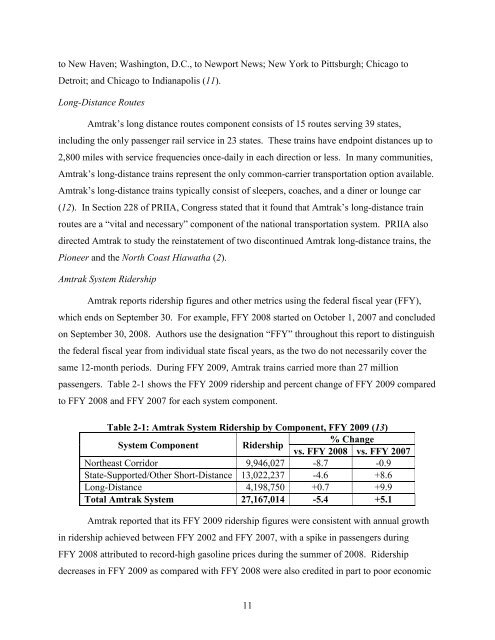Measuring the Benefits of Intercity Passenger Rail: A Study
Measuring the Benefits of Intercity Passenger Rail: A Study
Measuring the Benefits of Intercity Passenger Rail: A Study
You also want an ePaper? Increase the reach of your titles
YUMPU automatically turns print PDFs into web optimized ePapers that Google loves.
to New Haven; Washington, D.C., to Newport News; New York to Pittsburgh; Chicago to<br />
Detroit; and Chicago to Indianapolis (11).<br />
Long-Distance Routes<br />
Amtrak’s long distance routes component consists <strong>of</strong> 15 routes serving 39 states,<br />
including <strong>the</strong> only passenger rail service in 23 states. These trains have endpoint distances up to<br />
2,800 miles with service frequencies once-daily in each direction or less. In many communities,<br />
Amtrak’s long-distance trains represent <strong>the</strong> only common-carrier transportation option available.<br />
Amtrak’s long-distance trains typically consist <strong>of</strong> sleepers, coaches, and a diner or lounge car<br />
(12). In Section 228 <strong>of</strong> PRIIA, Congress stated that it found that Amtrak’s long-distance train<br />
routes are a “vital and necessary” component <strong>of</strong> <strong>the</strong> national transportation system. PRIIA also<br />
directed Amtrak to study <strong>the</strong> reinstatement <strong>of</strong> two discontinued Amtrak long-distance trains, <strong>the</strong><br />
Pioneer and <strong>the</strong> North Coast Hiawatha (2).<br />
Amtrak System Ridership<br />
Amtrak reports ridership figures and o<strong>the</strong>r metrics using <strong>the</strong> federal fiscal year (FFY),<br />
which ends on September 30. For example, FFY 2008 started on October 1, 2007 and concluded<br />
on September 30, 2008. Authors use <strong>the</strong> designation “FFY” throughout this report to distinguish<br />
<strong>the</strong> federal fiscal year from individual state fiscal years, as <strong>the</strong> two do not necessarily cover <strong>the</strong><br />
same 12-month periods. During FFY 2009, Amtrak trains carried more than 27 million<br />
passengers. Table 2-1 shows <strong>the</strong> FFY 2009 ridership and percent change <strong>of</strong> FFY 2009 compared<br />
to FFY 2008 and FFY 2007 for each system component.<br />
Table 2-1: Amtrak System Ridership by Component, FFY 2009 (13)<br />
System Component Ridership<br />
% Change<br />
vs. FFY 2008 vs. FFY 2007<br />
Nor<strong>the</strong>ast Corridor 9,946,027 -8.7 -0.9<br />
State-Supported/O<strong>the</strong>r Short-Distance 13,022,237 -4.6 +8.6<br />
Long-Distance 4,198,750 +0.7 +9.9<br />
Total Amtrak System 27,167,014 -5.4 +5.1<br />
Amtrak reported that its FFY 2009 ridership figures were consistent with annual growth<br />
in ridership achieved between FFY 2002 and FFY 2007, with a spike in passengers during<br />
FFY 2008 attributed to record-high gasoline prices during <strong>the</strong> summer <strong>of</strong> 2008. Ridership<br />
decreases in FFY 2009 as compared with FFY 2008 were also credited in part to poor economic<br />
11
















